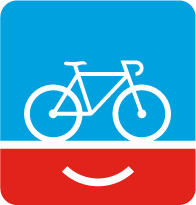Mueller District Finds Cycle Tracks Good for Business in Austin
By: Jen Reel
The first thing that struck me when I walked into the main administrative building for Mueller was the mounted bicycle hanging over the diorama. I was meeting with some representatives from Catellus Development Group, the master developer of the Mueller mixed-use village, to find out what motivated them to put cycle tracks on their streets.
Carl Paulsen, vice president of construction for Catellus, led me into a room while I noted the bicycle on the wall. “Does that inspire you to bike to work?” I asked. “I just got a bike for Christmas so we’ll see what happens,” said Paulsen. He claimed in the past he’d felt uneasy sharing the road with automobiles. Mueller is the first project that Cotellus has worked with cycle tracks, so experiencing this process by working with experts and seeing cycle tracks sprout up in other areas of Austin has given him some confidence.
Just then Deanne Desjardin, the vice president of marketing, walked in and shook my hand. Dee’s enthusiasm for her job was obvious as soon as she began talking, and not in the, “I’m going to tell you what my company wants you to hear because it’s my job” kind of way. She’s genuinely excited about Mueller.
Before I get into how cycle tracks came to be in Mueller, let me back up and say that when I moved to Austin over six years ago, one of the first things I noticed was a collective disdain for developers in general. People seemed to be actively fighting them (or complaining loudly from their armchairs) everywhere I turned. The sprawl! The greed! The insensitivity to neighborhood aesthetics! I had heard a lot of complaining, and in many cases, rightly so. I heard the word “Mueller” pass from some of their disgruntled lips early on, too. But I would argue that those who complained, didn’t understand what Mueller was setting out to be or how we would benefit from it.
“Let me set the stage for how things happened,” says Desjardin, before launching into the history of Mueller. During the 30’s, Mueller used to be the municipal airport. Sometime in the 80’s, residents in the surrounding neighborhoods began voicing their concern about the airport’s likely expansion. They organized and relentlessly engaged the city about relocating the airport and creating a mixed-use community in it’s place. When the Bergstrom Air Force Base was slated to be decommissioned by the Pentagon, that location proved a no-brainer for the airport. When the base officially closed in ’99, the plan was put into motion and today we have Mueller.
So, what is Mueller?
According to the Mueller website, the original vision of Mueller was to “create a district that would be a model for responsible urban development?an alternative to land-consumptive and automobile-dependant development patterns throughout the region that could influence the form and pattern of growth within Austin.” The street grid at Mueller is all about managing traffic and creating a pedestrian-friendly and bike-friendly, less auto dependent community where people can walk to work, stores, restaurants and homes.
Mueller isn’t just for its current and future residents, it’s a big-picture project for Austin. It’s actually a joint-project with the city of Austin, and it captures a lot of the concepts formed in the Imagine Austin plan and did so well before there even was an Imagine Austin plan. The parks in Mueller are city parks. The streets, public streets. Council member Chris Riley bikes these streets, and during a conversation with Catellus executive vice president Greg Weaver, he noted that cycle tracks were implemented elsewhere in Austin and he discussed the benefits to adding them into Mueller’s own bike plans. Thirteen miles of bike lanes, both on-road and off-road, are anticipated in Mueller upon completion. After speaking with council member Riley, Mr. Weaver advised Mr. Paulsen to “check it out,” and the rest is history. Paulsen has been working closely with Nathan Wilkes and others in the city’s bike program department to get it right. Tom Wald, executive director of Bike Austin, has provided extensive feedback for Catellus. “It’s not just us sitting here in the development department saying, ‘oh, let’s build out.’ It’s engaging the community and finding out what works and what doesn’t,” says Paulsen.
So, is it good for business?
“We have a lot of Mueller residents that cycle to work,” says Desjardin. “For them, this is getting them into the rest of the network. We’re enhancing and further connecting the cycling network that Austin is doing city wide, and that attracts a lot of people and businesses. We’ve gotten feedback when talking to residents about the cycle tracks. There is that enthusiasm for being able to cycle as a family and feeling more secure. We were charged with the responsibility of knitting all these areas back together in something that would be cohesive and seamless and actually enhance the existing neighborhoods, so what we’re delivering, we’re delivering to all of Austin.”
Currently a section of cycle track sits on Berkman Drive, with expansion planned in the near future as Mueller is built out. One of the more exciting things is the potential for a 2-way cycle track on Zach Scott, which will allow parents and students to bike to the elementary school that is also in Mueller’s future. Stay tuned.

